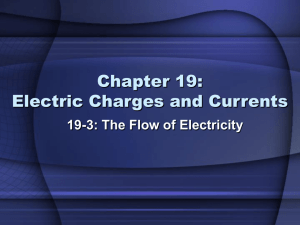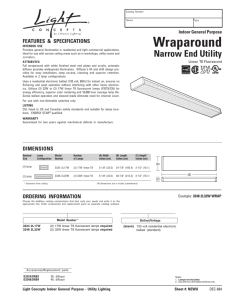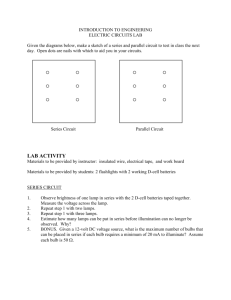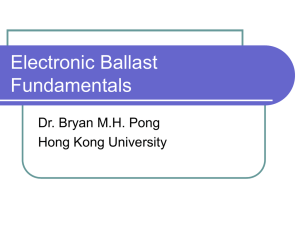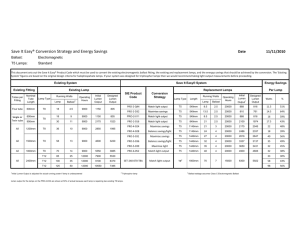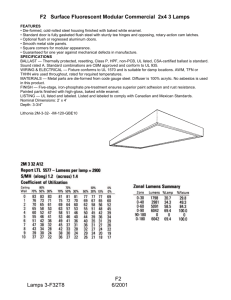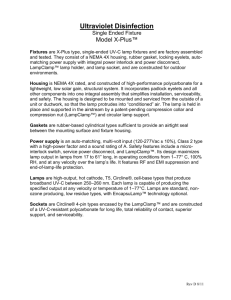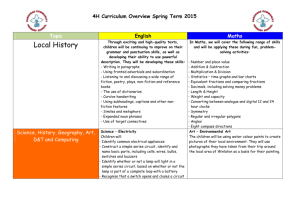IECON2003EBP
advertisement
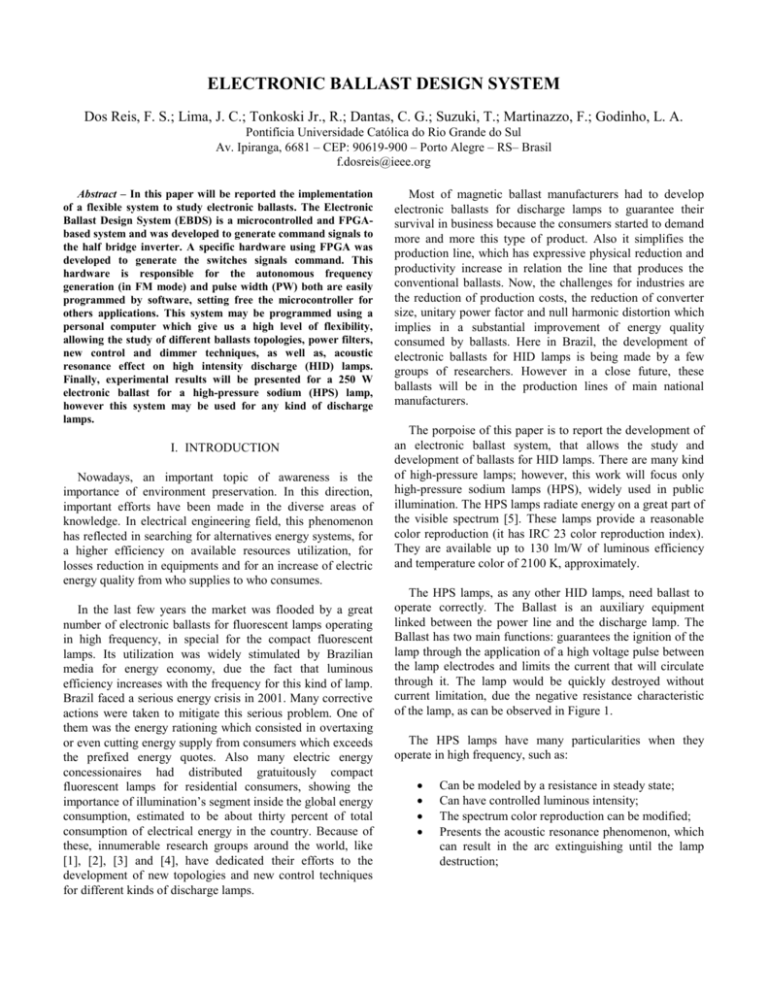
ELECTRONIC BALLAST DESIGN SYSTEM Dos Reis, F. S.; Lima, J. C.; Tonkoski Jr., R.; Dantas, C. G.; Suzuki, T.; Martinazzo, F.; Godinho, L. A. Pontifícia Universidade Católica do Rio Grande do Sul Av. Ipiranga, 6681 – CEP: 90619-900 – Porto Alegre – RS– Brasil f.dosreis@ieee.org Abstract – In this paper will be reported the implementation of a flexible system to study electronic ballasts. The Electronic Ballast Design System (EBDS) is a microcontrolled and FPGAbased system and was developed to generate command signals to the half bridge inverter. A specific hardware using FPGA was developed to generate the switches signals command. This hardware is responsible for the autonomous frequency generation (in FM mode) and pulse width (PW) both are easily programmed by software, setting free the microcontroller for others applications. This system may be programmed using a personal computer which give us a high level of flexibility, allowing the study of different ballasts topologies, power filters, new control and dimmer techniques, as well as, acoustic resonance effect on high intensity discharge (HID) lamps. Finally, experimental results will be presented for a 250 W electronic ballast for a high-pressure sodium (HPS) lamp, however this system may be used for any kind of discharge lamps. I. INTRODUCTION Nowadays, an important topic of awareness is the importance of environment preservation. In this direction, important efforts have been made in the diverse areas of knowledge. In electrical engineering field, this phenomenon has reflected in searching for alternatives energy systems, for a higher efficiency on available resources utilization, for losses reduction in equipments and for an increase of electric energy quality from who supplies to who consumes. In the last few years the market was flooded by a great number of electronic ballasts for fluorescent lamps operating in high frequency, in special for the compact fluorescent lamps. Its utilization was widely stimulated by Brazilian media for energy economy, due the fact that luminous efficiency increases with the frequency for this kind of lamp. Brazil faced a serious energy crisis in 2001. Many corrective actions were taken to mitigate this serious problem. One of them was the energy rationing which consisted in overtaxing or even cutting energy supply from consumers which exceeds the prefixed energy quotes. Also many electric energy concessionaires had distributed gratuitously compact fluorescent lamps for residential consumers, showing the importance of illumination’s segment inside the global energy consumption, estimated to be about thirty percent of total consumption of electrical energy in the country. Because of these, innumerable research groups around the world, like [1], [2], [3] and [4], have dedicated their efforts to the development of new topologies and new control techniques for different kinds of discharge lamps. Most of magnetic ballast manufacturers had to develop electronic ballasts for discharge lamps to guarantee their survival in business because the consumers started to demand more and more this type of product. Also it simplifies the production line, which has expressive physical reduction and productivity increase in relation the line that produces the conventional ballasts. Now, the challenges for industries are the reduction of production costs, the reduction of converter size, unitary power factor and null harmonic distortion which implies in a substantial improvement of energy quality consumed by ballasts. Here in Brazil, the development of electronic ballasts for HID lamps is being made by a few groups of researchers. However in a close future, these ballasts will be in the production lines of main national manufacturers. The porpoise of this paper is to report the development of an electronic ballast system, that allows the study and development of ballasts for HID lamps. There are many kind of high-pressure lamps; however, this work will focus only high-pressure sodium lamps (HPS), widely used in public illumination. The HPS lamps radiate energy on a great part of the visible spectrum [5]. These lamps provide a reasonable color reproduction (it has IRC 23 color reproduction index). They are available up to 130 lm/W of luminous efficiency and temperature color of 2100 K, approximately. The HPS lamps, as any other HID lamps, need ballast to operate correctly. The Ballast is an auxiliary equipment linked between the power line and the discharge lamp. The Ballast has two main functions: guarantees the ignition of the lamp through the application of a high voltage pulse between the lamp electrodes and limits the current that will circulate through it. The lamp would be quickly destroyed without current limitation, due the negative resistance characteristic of the lamp, as can be observed in Figure 1. The HPS lamps have many particularities when they operate in high frequency, such as: Can be modeled by a resistance in steady state; Can have controlled luminous intensity; The spectrum color reproduction can be modified; Presents the acoustic resonance phenomenon, which can result in the arc extinguishing until the lamp destruction; Positive Resistance Lamp Current Negative Resistance Lamp Voltage Breakdown Voltage This system can be used with push-pull, bridge and halfbridge inverter. For this paper a half-bridge inverter was implemented. II. ELECTRONIC BALLAST DESIGN SYSTEM The system structure incorporates an input LC Filter, a soft start circuit to limit the inrush current, a power factor preregulator (PFP), a control circuit (C FPGA), a power inverter, an optocoupler driver circuit and a LCC ballast. The figure 2 shows the control pulse generator block diagram, of the Electronic Ballast Design System (EBDS). Soft Start PFP Figure 1. Typical voltage x current curve for HID lamps. Computer RS-232 The idea of developing a flexible system to study electronic ballasts came from a previous LCC ballast prototype implementation for high-pressure sodium (HPS) lamps using the CC-CC dedicated controller CI 3524. The observed experimental results showed that was possible to avoid the acoustic resonance phenomenon varying the control frequency operation. Also it was possible to observe in this first prototype that sudden variations of operation frequency resulted in color reproduction alterations. The flexible system was implemented using a microcontroller based circuit system able to generate command signals for the inverter switches. The command signal is generated using a FPGA. The hardware using the FPGA is responsible for the command signals generation: operation frequency (in FM mode) and pulse width (PW). The command signals are easily programmed by the microcontroller, setting it free for others applications like circuit protection. The FPGA dedicate system allows working in different frequency ranges. For example, if it was used a 50 MHz crystal, the frequency output would work from 40 Hz to 180 kHz. The duty cycle control can run from 0 to 100% in 16 different combinations, allowing a full system control. µController FPGA Based Digital PLL & PWM Optocoupler & Driver Circuit Command Signals Pulse Generator Figure 2. Control pulse generator. The control pulse generator consists of three circuits: a microcontroller based circuit, which is responsible for the control technique implementation and by interface between the personal computer and the switches command signal. The microcontroller has a serial RS-232 interface with the PC. The switches command signal are generated using a digital frequency synthesizer circuit [6] based on a digital PLL which was implemented in an Altera FPGA (EPM7064). The microcontroller works stand-alone but it is possible using a personal computer programs to control the FPGA parameters directly. The third one is an optocoupler circuit to isolate the control system from the power system using 74OL6010 and a driver circuit using IR2110. The EBDS allows to test and to evaluate new power structures and new control strategies for electronic ballasts. The proposed EBDS block diagram is presented in figure 3. This system is programmed using a PC based program developed in Delphi. As we can see in figure 4, this program has a simple interface allowing easy parameters variation. Figure 3. EBDS block diagram. Clock Reference Scom Tuning Word Serial Interface Fin Digital PLL Load Fout Fin * n 216 Variable Frequency PWM Out Duty Cycle PWM Load Adjustable Digital Dead Time Sdat Sclk C Serial Interface To Drive Circuit Figure 7. – Implemented control signal generator with dead time. Figure 4. Input window of the developed PC program interface. The EBDS allows creating different programs to command it, where can be implemented different control strategies for commanding the lamp. For example, our circuit can implement sine wave, tooth wave, triangle wave, square wave and a point by point wave frequency variation around an operation frequency. The EBDS allow investigating new control techniques focused in to avoid acoustic resonance and to obtain a new spectrum of color reproduction. The control circuit developed for this application is presented in figure 5 and 6. This circuit was based on AT89C52 microcontroller from Atmel’s 8051 family. The digital PLL command signal generator is based in a FPGA that receives the frequency and duty cycle references values from the C circuit, serially and, therefore it modulates the output signal in the desired conditions with programmable dead time. The digital PLL is presented in figure 7. This circuit needs two tuning words to work properly. These words are received from the C, which refer to the duty cycle and frequency programming. The digital PLL circuit generates a square wave obtained from a high frequency reference signal. Using the technique of frequency synthesis [7] based on a digital PLL implementation is obtained the desired frequency. This technique is based on adders and programmable step counters. Starting at a clock reference and an input value for the desired frequency and duty cycle, the digital PLL adjusts the output frequency as: nF Fout 16in 2 (1) This digital PLL circuit, implemented on a FPGA, is based on an adjusted phase accumulator as shown in figure 8. The square wave Fout is used as clock reference, and with this signal we can obtain the control signal shown in figure 9. This modulation is made from a counter comparison with the programmed duty cycle; afterwards it is already obtained the signal with desired frequency and duty cycle. Subsequently, the signal is dead time adjusted with the phase and its contra phase. This dead time was digitally implemented. Phase Accumulator Frequency Tuning Word 8051 Microcontroller CPU 12 16 Reg. 16 Fout Phase/Ampl. Conversion Reg. Figure 5. 8051 Based Microcontroller CPU. Load Microcontroller Serial Interface Clock Reference 48 MHz Clock Reference Digital PLL Figure 8. – FPGA implemented digital PLL. III. DRIVER AND POWER CIRCUIT FPGA Based PWM Optocouplers Figure 6. FPGA based Digital PLL circuit. The EBDS was developed to work with the most significant power inverters topologies like push-pull, halfbridge and bridge. theory we would have the possibility of an infinite voltage generation over the lamp which could be good for a quickly lamp turn on. On the other hand the current also would rise to infinity because the fact that the impedance of the circuit formed by L, Cs and Cp before the turn on of the lamp is null. This operation mode will result in the MOSFET’s, driver’s and optocoupler destruction. N-Bits Counter fin A PWM Out Comparator A>B B Duty Cicle Word Load Duty Cicle Register L Ve Figure 9. – Control signal FPGA implemented. In figure 10 is shown the elaborated driver for one power leg. The IR2110 driver was used to supply appropriate command signals to the Mosfets. 400 Vcc Cp 14 9 2 10 1 11 The reference [2] and our experimental results allow us to consider that after lamps ignition, the lamp resistance is too low considering the Cp reactance. Therefore, it can be deduced the equation 3: 1 // R R CP 12 13 14 HO VDD VB HIN VS SD LIN VSS R Figure 11. – LCC Ballast. U1 VCC Cs VCC COM LO (3) 7 6 5 Consequently, we can say that, after lamp ignition, the equivalent circuit is showed in figure 12. VCC 3 2 1 2 L Cs 1 IR2110 Figure 10. – Inverter drive and power leg. Ve IV. DESIGN EXAMPLE Figure 12. – Ballast equivalent circuit after ignition. To verify the EBDS performance a LCC electronic ballast for a 250 W HPS lamp was built. The implemented PFP is a Boost converter working in the boundary conditions between continuous conduction mode and discontinuous conduction mode. Therefore, it works in FM mode; the PFP has a universal input from 100 to 240 V and supplies 250 W at its 400 V output. For the implementation of the LCC ballast it was chosen a 68 kHz switching frequency. As we can see in the lamp’s manufacturer records, the nominal voltage for this lamp is 100 VRMS, for the project of the LCC ballast it was added 10 % because the loses effect and the power voltage comes from the output of the PFP therefore it is 400 VDC. Assuming the resistive comportment of the lamp, we can estimate the value of its resistance after ignition using equation 2. R Vl 2 40 P R (2) As it was indicated in the reference [2], the best relationship between the switching frequency and the resonance frequency before the lamp turn on is ω0/ ωs = 3, guaranteeing the high voltage generation for the lamp ignition and limiting the peak current at the MOSFET to acceptable levels. If it was adopted to work at resonance ω0 = ωs in For the circuit showed in figure 12, considering the voltage Ve an asymmetrical square wave (from E to 0 V). It is easy to obtain the peak value Vm of the first harmonic from Fourier series. The equation 4 has shown this value: Vm 2E (4) After lamp ignition the ballast must guaranty that RMS voltage over the lamp do not overcome the nominal value. The peak lamp voltage Vl can be obtained using the well known voltage divider for the circuit shown in figure 12, the equation 5 presents this result: Vl R Vm Z (5) The impedance of the circuit can be calculated with equation 6. To facilitate the design of the LCC filter an impedance abacus was elaborated and the result is shown in figure 13. This abacus presents the relationship between the Z/R for a fixed operation frequency ω0/ωs = 3, having the quality factor Ql and the capacitor relationship factor defined as A=Cp/Cs as design parameters. 1 A1 o R 1 o A L 220 H . j Ql 0 Q 1 A l o Z Ql , A In the case of the capacitors, we have that: R Ql , 1 jQl 1 A C 0 R o (6) Gráfico da Variação da Impedância em função de Ql variando-se o parâmetro A C 1 A Cs 57 nF 4 A and 1 Z Ql 20 25 30 Z Ql Z Ql 2 C P A C s 2,9nF 10 1 Z Ql 15 Z Ql 1 (13) (14) V. EXPERIMENTAL RESULTS (12) 3 2 The digital control system was implemented the halfbridge command signals for different values of switching frequency are presented in figure 14. 1 1 (11) 1 GS( Ql) 0 0 0.05 0.1 0.15 0.2 0.25 0.3 0.35 Ql Figure 13. – Impedance graphic varying Ql for different values of A. Where, Ql o RC R (7) o L , C CS CP CS CP (8) CP CS (9) and, A As it could be seen in the abacus of figure 13, if it is used a capacitor’s relationship factor value lower then 1/20, there is no significative change in the abacus curve. Considering this, the adopted A factor was A=1/20. In the present design the relationship between Z/R could be obtained from equation (5). Remember that the most important thing is to maintain the nominal RMS voltage in the HPS lamp, so a new equation can be write to solve this problem the equation (10) presents this relation, for the present design results: Z R 2 E 2 Vl 2 400 2 110 1,637 (10) From the abacus of figure 13, the obtained Ql value is 0,141 as we can see in the intersection of the horizontal axis Ql and vertical axis Z(Ql,1/20), allowing the calculus of the resonances elements. The inductor value can be obtained from equation (7) and yields in equation 11: Figure 14. – Inverter driver signal at nominal frequency. To validate the proposed system, half-bridge electronic ballast with the following specification: 250 W HPS lamp, 400 VDC bus and minimum operation frequency of 68 kHz, was implemented. The values of used resonant elements was obtained from using a tuned LCC resonant filter with L = 220 H, Cs=55 nF witch was implemented with five 11 nF capacitors in parallel and Cp = 2.73 nF witch was implemented with tree 8.2 nF capacitors in series. In this kind of ballast, the lamp ignition is critical, because the ballast uses a tuned LCC resonant circuit with passive elements that may have its values changed by many different reasons like temperature variation, life time and assembling factors. In this way, the EBDS system avoids this problem by making that ignition frequency variable around the nominal value, in this case 68 kHz. In figure 15 is showed the voltage and current in the lamp where it can be observed its resistive characteristic. In figure 16 is showed the achieved 250 W lamp power consumption. making possible the creation of new and more efficient control strategies for electronic ballasts. The present system allows the study of the control strategies influences in lamps lifetime, in new dimming techniques implementation, in avoiding acoustic resonance and in color reproduction alterations. The EBDS presents a high power factor and works properly from 100 to 240 V. The experimental results obtained were satisfactory. VII. ACKNOWLEDGEMENTS Figure 15. –Voltage and current Lamp. Figure 16. –Instantaneous power consumption in the lamp. Figure 17. – Input PFP voltage and current. The implemented Boost PFP working in the boundary conditions between continuous conduction mode and discontinuous conduction mode works properly as shown in figure 17. VI. CONCLUSION This paper described a flexible system implementation using a microcontroller and FPGA based circuit system able to generate command signals for the ballast switches. This system allows easy control of the parameters variation, The authors wants to thanks CEEE “Companhia Estadual de Energia Elétrica” and CNPq “Conselho Nacional de Desenvolvimento Científico e Técnológico” to the financial support given which made possible the realization of this project. VIII. REFERENCES [1] Ben-Yaakov, S.; Gulko, M.; “Design and performance of an electronic ballast for high-pressure sodium (HPS) lamps, Industrial Electronics”, IEEE Transactions on Volume: 44 Issue: 4, Aug 1997, Page(s): 486 -491 [2] Bum Suk Kang; Hee Jun Kim; High Power Factor Electronic Ballast for High Pressure Sodium Lamp, TENCON 99. Proceedings of the IEEE Region 10 Conference, Volume: 2, Dec 1999, Page(s): 887 -890 vol.2. [3] Bisogno, F.E.; Seidel, A.R.; Holsbach, R.; do Prado, R.N.; Resonant filter applications in electronic ballast, Industry Applications Conference, 2002. 37th IAS Annual Meeting. Conference Record of the, Volume: 1, 2002, Page(s): 348 -354 vol.1 [4] Co, M.A.; Resende, C.Z.; Simonetti, D.S.L.; Vieira, J.L.F.; Almeida, P.C.A.; Microcontrolled electronic gear for low wattage metal halide (MH) and high-pressure sodium (HPS) lamps, Industry Applications Conference, 2002. 37th IAS Annual Meeting. Conference Record of the, Volume: 3, 2002, Page(s): 1863 -1868 vol.3 [5] J.R. Coaton, Lamps and Lighting, fourth edition, Arnold 1997. [6] Vanka, Jouko, A Direct Digital Synthesizer with a Tunable Error Feedback Structure, IEEE Transaction on Communication, Vol. 45, nº. 4, April, 1997 [7] Kobayashi, F., Haratsu, M., A Digital PLL with Finite Impulsive Response, Circuits and Systems, 1995. ISCAS '95. 1995 IEEE International Symposium on , Volume: 1 , 30 Apr-3 May 1995, Page(s): 191 -194 vol.1 [8] Alves, J.A.; Perin, A.J.; Barbi, I.; “An electronic ballast with high power factor for compact fluorescent lamps, Industry Applications Conference”, 1996. Thirty-First IAS Annual Meeting, IAS '96. Conference Record of the 1996 IEEE , Volume: 4 , 6-10 Oct 1996, Page(s): 2129 2135 vol.4.
